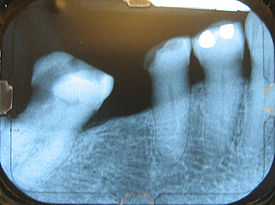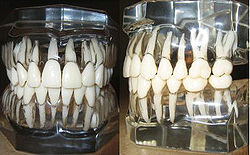
Crown-to-root ratio
Encyclopedia

Ratio
In mathematics, a ratio is a relationship between two numbers of the same kind , usually expressed as "a to b" or a:b, sometimes expressed arithmetically as a dimensionless quotient of the two which explicitly indicates how many times the first number contains the second In mathematics, a ratio is...
of the length of the part of a tooth that appears above the alveolar bone versus what lies below it. It is an important consideration in the diagnosis, treatment planning and restoration of teeth, one that hopefully guides the plan of treatment to the proper end result.
Anatomical terms
All teeth have two general sections, the crown and the root. Because the crown is covered with enamelTooth enamel
Tooth enamel, along with dentin, cementum, and dental pulp is one of the four major tissues that make up the tooth in vertebrates. It is the hardest and most highly mineralized substance in the human body. Tooth enamel is also found in the dermal denticles of sharks...
and the root is covered with cementum
Cementum
Cementum is a specialized calcified substance covering the root of a tooth. Cementum is excreted by cells called cementoblasts within the root of the tooth and is thickest at the root apex. These cementoblasts develop from undifferentiated mesenchymal cells in the connective tissue of the dental...
, the line at which these two sections join is called the cementoenamel junction
Cementoenamel junction
The cementoenamel junction, frequently abbreviated as the CEJ, is an anatomical border identified on a tooth. It is the location where the enamel, which covers the anatomical crown of a tooth, and the cementum, which covers the anatomical root of a tooth, meet...
. In health, the roots of teeth are entirely surrounded by and submerged in the alveolar bone of either the maxilla
Maxilla
The maxilla is a fusion of two bones along the palatal fissure that form the upper jaw. This is similar to the mandible , which is also a fusion of two halves at the mental symphysis. Sometimes The maxilla (plural: maxillae) is a fusion of two bones along the palatal fissure that form the upper...
or the mandible, depending on whether the tooth in question is an upper or a lower tooth, up until the cementoenamel junction. Overlying the bone is the gingiva
Gingiva
The gingiva , or gums, consists of the mucosal tissue that lies over the mandible and maxilla inside the mouth.-General description:...
l soft tissue, which is, on average, about 1 millimeter in thickness. Because of this gingiva, the crown, which exists entirely outside of the surrounding bone, is somewhat obscured at the apical
Commonly used terms of relationship and comparison in dentistry
There are numerous commonly used terms of relationship and comparison that refer to different aspects of teeth and are frequently utilized in articles about dentistry...
millimeter or so. Thus, crown and root can be used as anatomical
Anatomy
Anatomy is a branch of biology and medicine that is the consideration of the structure of living things. It is a general term that includes human anatomy, animal anatomy , and plant anatomy...
terms, defining the actual parts of a tooth. Gingival recession is a related condition to decreased crown-to-root ratio, but referring to gingiva
Gingiva
The gingiva , or gums, consists of the mucosal tissue that lies over the mandible and maxilla inside the mouth.-General description:...
.
Clinical terms
These terms can also be used to refer to the clinical sense of the words, as relative crown and relative root, by describing how much tooth remains surrounded by bone. As the inflammation associated with periodontal diseasePeriodontal disease
Periodontitis is a set of inflammatory diseases affecting the periodontium, i.e., the tissues that surround and support the teeth. Periodontitis involves progressive loss of the alveolar bone around the teeth, and if left untreated, can lead to the loosening and subsequent loss of teeth...
causes the bone to resorb and disappear, revealing more of the root structure, the effective crown height in relation to the effective root height is reduced and the prognosis
Prognosis
Prognosis is a medical term to describe the likely outcome of an illness.When applied to large statistical populations, prognostic estimates can be very accurate: for example the statement "45% of patients with severe septic shock will die within 28 days" can be made with some confidence, because...
shifts from favorable to unfavorable.
Clinical importance

Naturally, the cementoenamel junction exists much closer to the incisal or occlusal
Commonly used terms of relationship and comparison in dentistry
There are numerous commonly used terms of relationship and comparison that refer to different aspects of teeth and are frequently utilized in articles about dentistry...
surface of a tooth than to the tip of the root or roots. Because of this fact, root length is considerably longer than crown length, and this helps allow for proper support of the teeth during normal function, not unlike a tree that has a root system hidden below ground which is more often than not considerably larger and more elaborate than the form taken by the growing branches. If a towering tree doesn't have enough support provided by its root system, it will easily be knocked over in even a slight wind; similarly, a tooth requires a sturdy root system encased in bone to protect it from being knocked out of the mouth.
The natural crown-to-root ratio is thus termed a favorable crown-to-root ratio, because the root system existing within the surrounding bone is more than sufficient to support the tooth under normal physiologic
Physiology
Physiology is the science of the function of living systems. This includes how organisms, organ systems, organs, cells, and bio-molecules carry out the chemical or physical functions that exist in a living system. The highest honor awarded in physiology is the Nobel Prize in Physiology or...
stresses. After some bone loss is incurred, though, and more root structure is visible outside of the supporting bone, not only is there less effecive root support, but there is an increased height of revealed tooth structure that this now diminished submerged root is responsible for supporting. In a way, then, each millimeter of lost bone contributes, for example, to a millimeter of less support and a millimeter of more structure to support. As can be extrapolated, this can easily become a very serious problem once three, four or five millimeters of bone have been lost due to periodontal disease. The minimum crown-to-root ratio necessary is 1:1; any less support provided by the roots drastically reduces the prognosis of the tooth and its restoration.

Occlusal trauma
Occlusal trauma is a dental term that refers to the damage incurred when teeth are left in traumatic occlusion without proper treatment.When the maxillary and mandibular dental arches approach each together, as they do, for example, during chewing or at rest, the relationship between the opposing...
.

